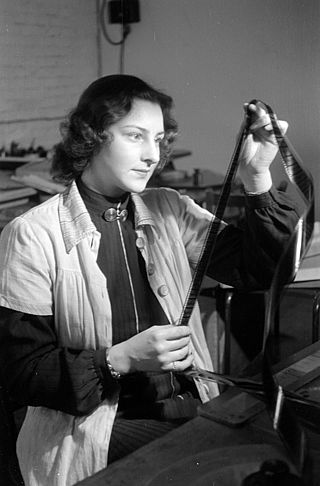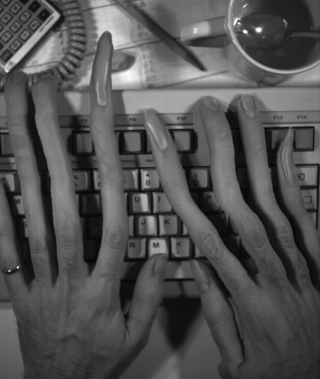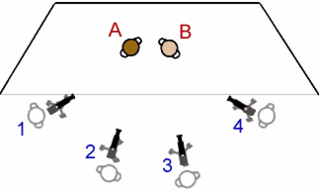In film and video, a cutaway is the interruption of a continuously filmed action by inserting a view of something else. It is usually followed by a cut back to the first shot. A cutaway scene is the interruption of a scene with the insertion of another scene, generally unrelated or only peripherally related to the original scene. The interruption is usually quick, and is usually, although not always, ended by a return to the original scene. The effect is of commentary to the original scene and creates variety.

Film editing is both a creative and a technical part of the post-production process of filmmaking. The term is derived from the traditional process of working with film which increasingly involves the use of digital technology. When putting together some sort of video composition, typically, you would need a collection of shots and footages that vary from one another. The act of adjusting the shots you have already taken, and turning them into something new is known as film editing.

In film, an insert is a shot of part of a scene as filmed from a different angle and/or focal length from the master shot. Inserts cover action already covered in the master shot, but emphasize a different aspect of that action due to the different framing. An insert differs from a cutaway as cutaways cover action not covered in the master shot.
Cut, copy, and paste are essential commands of modern human–computer interaction and user interface design. They offer an interprocess communication technique for transferring data through a computer's user interface. The cut command removes the selected data from its original position, and the copy command creates a duplicate; in both cases the selected data is kept in temporary storage called the clipboard. Clipboard data is later inserted wherever a paste command is issued. The data remains available to any application supporting the feature, thus allowing easy data transfer between applications.

Ealing Studios is a television and film production company and facilities provider at Ealing Green in West London, London, England. Will Barker bought the White Lodge on Ealing Green in 1902 as a base for film making, and films have been made on the site ever since. It is the oldest continuously working studio facility for film production in the world, and the current stages were opened for the use of sound in 1931.

In film and television production, B-roll, B roll, B-reel or B reel is supplemental or alternative footage intercut with the main shot. The term A-roll, referring to main footage, has fallen out of use.

A close-up or closeup in filmmaking, television production, still photography, and the comic strip medium is a type of shot that tightly frames a person or object. Close-ups are one of the standard shots used regularly with medium and long shots. Close-ups display the most detail, but they do not include the broader scene. Moving toward or away from a close-up is a common type of zooming. A close up is taken from head to neck, giving the viewer a detailed view of the subject's face.

A film transition is a technique used in the post-production process of film editing and video editing by which scenes or shots are combined. Most commonly this is through a normal cut to the next shot. Most films will also include selective use of other transitions, usually to convey a tone or mood, suggest the passage of time, or separate parts of the story. These other transitions may include dissolves, L cuts, fades, match cuts, and wipes.

The slit-scan photography technique is a photographic and cinematographic process where a moveable slide, into which a slit has been cut, is inserted between the camera and the subject to be photographed.
Cross-cutting is an editing technique most often used in films to establish action occurring at the same time, and often in the same place. In a cross-cut, the camera will cut away from one action to another action, which can suggest the simultaneity of these two actions but this is not always the case. Cross-cutting can also be used for characters in a film with the same goals but different ways of achieving them.

The Rosie O'Donnell Show is an American daytime variety television talk show created, hosted, and produced by actress and comedian Rosie O'Donnell. It premiered on June 10, 1996, and concluded after six seasons on May 22, 2002.
This article contains a list of cinematic techniques that are divided into categories and briefly described.
Rear projection is one of many in-camera effects cinematic techniques in film production for combining foreground performances with pre-filmed backgrounds. It was widely used for many years in driving scenes, or to show other forms of "distant" background motion.
Camera coverage, or coverage, is the amount and kind of footage shot used to capture a scene in filmmaking and video production. The film editor uses coverage in post-production to assemble the final cut.
Montage is a film editing technique in which a series of short shots are sequenced to condense space, time, and information.

The single-camera setup, or single-camera mode of production, also known as portable single crew, portable single camera or single-cam, is a method of filmmaking and video production.

The multiple-camera setup, multiple-camera mode of production, multi-camera or simply multicam is a method of filmmaking and video production. Several cameras—either film or professional video cameras—are employed on the set and simultaneously record or broadcast a scene. It is often contrasted with a single-camera setup, which uses one camera.
Walk and talk is a storytelling technique used in filmmaking and television production in which a number of characters have a conversation while walking somewhere. Walk and talk often involves a walking character who is then joined by another character. On their way to their destinations, the two talk. Variations include interruptions from other characters and walk and talk relay races, in which new characters join the group and one of the original characters leaves the conversation, while the remaining characters continue the walking and talking.
A documentary film is a film story concerning factual topics. These films have a variety of aims: to record specific events and ideas; to inform viewers; to convey opinions and to create public interest. A number of common techniques or conventions are used in documentaries to achieve these aims.
This glossary of motion picture terms is a list of definitions of terms and concepts related to motion pictures, filmmaking, cinematography, and the film industry in general.









